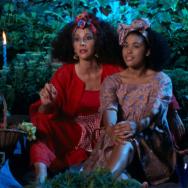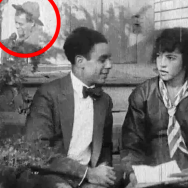As Elizabeth Myles’s, AB’20, sizzle reel played, sighs of recognition, claps and cheers rang out at each clip. Many of the filmmakers were in the audience. “I’m in tears because you’ve put all our films in conversation with each other,” said festival co-organizer and filmmaker Yvonne Welbon.
The Sojourner Truth Festival of the Arts 2023 culminated in a symposium that brought together film and literary veterans with contemporary artists, archivists, and scholars. Held at the David and Reva Logan Center for the Arts, the gathering paid homage to the original 1976 Sojourner Truth Festival held in New York—believed to be the first ever Black women’s film festival. Participants, many of whom attended the original 1976 festival, traveled from Europe, South America and across the U.S. to attend. Some reunited for the first time in 47 years.
The symposium began with the final screening of a 9-week film series held in conjunction with a course taught by Assoc. Prof. Allyson Nadia Field. Students in “Creating a Different Image: Black Women’s Filmmaking of the 1970s-90s” not only wrote program notes and helped facilitate screenings open to the public, but also served as volunteers at the main event.
During roundtable discussions about art and filmmaking in the 1970s, conversation flowed organically between audience members and panelists—many of them longtime collaborators. Together, participants pieced together memories of the original festival and past projects.
“We’re building this history right now,” said Hayley O’Malley, a film scholar and 2023 festival co-organizer.
Reunions and reminiscing happened throughout the weekend, though conversations quickly turned to the future. During Q&As, artists asked questions about navigating the pitfalls in a still-difficult industry. Scholars also emphasized the need for ongoing preservation and documentation.
“By looking back, we can give the contemporary legacies that we’re building a solid foundation,” said filmmaker and media conservator Ina Archer.
“The 70s were tumultuous times”
The original 1976 festival happened amid the Black Power movement, Vietnam War protests and the rise of feminism. It took place in New York City, a thriving arts hub whose key figures often used their art as a form of activism.
“The 70s were tumultuous times for feminists—and in particular, the Black feminist,” said keynote speaker Michele Wallace. “We founded groups together in the fight against the racism and sexism of the art world.”
During the legacy panel, several of the original 1976 participants recounted their own filmmaking origins. “It never occurred to most of us that we could even be behind the camera,” said writer, producer and director Carol Munday Lawrence. “We were not in front of the camera, unless we were maids, or criminals, or doing something clownish.”
Others spoke of navigating openly hostile environments or getting stuck in tokenized writing roles. Many filmmakers didn’t attend film schools, which were new and not always hospitable to Black women. Like Monica Freeman, who “learned film in the streets,” many women learned by creating their own projects or working alongside more established mentors.
A special tribute honored film legend Madeline Anderson, who was already a mentor and role model in 1976. Following the screening of Anderson’s documentary “I Am Somebody” (1970), director Ava DuVernay presented Anderson with the 2023 Woman of the Year Award, a nod to the award she received at the 1976 festival.
“Ms. Anderson has shattered barriers and opened doors previously closed to women and people of color,” said DuVernay in her pre-recorded remarks. “She has inspired generations of filmmakers and producers like myself to follow in her footsteps.”
Anderson, who at 95 is raising money to complete her final film, accepted via Zoom. “So many Black women filmmakers are making these beautiful films despite the struggle to get the money to make them,” Anderson said. “I’m hopeful the recognition of their work will convince the powers that be to let us in, to tell our stories. Because we’re more than capable and ready to do so.”
Preserving the past for the future
The original 1976 festival was nearly lost to time. Even those who’d attended held vague memories. Only a chance find in an archive allowed cinema scholar Hayley O’Malley to piece together the historic event. It’s no surprise that the importance of preservation remained a key theme throughout the weekend.
During a workshop on the symposium’s final day, media scholars outlined why films made by Black women aren’t always found in archives. Preservation efforts tend to mirror what our society values at the time—things made by marginalized groups often get erased.
Conservation specialists discussed best practices for storing and digitizing film. During panels about memory work and curation, participants advocated for collaboration between scholars and artists. “The role we can play is pushing against active erasures with the active and deliberate writing of history, formation of archives, and efforts at preserving these films and the filmmakers’ stories.” said Field. “This gathering is a major part of the history work.”
Scholars and filmmakers alike were motivated to create a foundation for the next generation of artists. Festival attendees sought advice on learning the craft or navigating an industry still plagued by inequity. Veterans in the field brought up unions and writers guilds as ways to build skills—the importance of funding and sustainable work. But, perhaps above all else, filmmakers emphasized collaboration.
“We don’t talk enough about collaboration and how important it is to raising the quality of all our work,” said video producer Jennie Bourne. “Mentorship could not be more important—those people who know the pitfalls and can warn you or help you to reach your goal.”
To the Festival’s co-organizers, Wallace said, “What you’ve done here is a superb demonstration of what happens when women pull together.”
—The Festival was presented by UChicago’s Film Studies Center, South Side Projections, Sisters in Cinema, and the Reva and David Logan Center for the Arts. It was co-sponsored by nearly 20 divisions and centers across the University as well as several outside partners.
—Events at the Neubauer Collegium were co-sponsored by the Visual Regimes of Enslavement and Their Afterlives research project.
—Additional reporting by Jess Hutchinson

